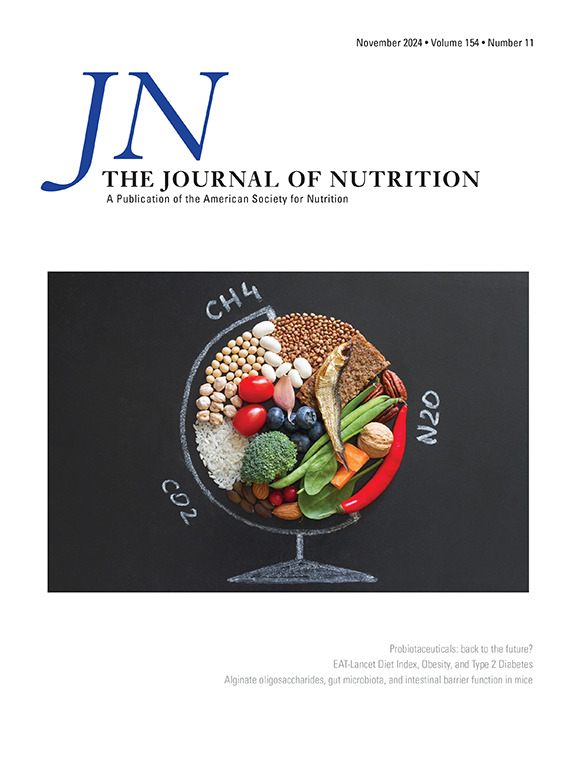Associations of Food Group Intakes with Serum Carbon Isotope Ratio Values in Youth: Results from 2 Prospective Pediatric Cohort Studies
IF 3.7
3区 医学
Q2 NUTRITION & DIETETICS
引用次数: 0
Abstract
Background
The carbon isotope ratio (CIR) is a candidate biomarker for sugar-sweetened beverage (SSB) intake in the United States. However, research specific to youth, who differ in their physiology and dietary patterns compared with adults, is lacking.
Objectives
We evaluated longitudinal associations of SSB intakes across childhood/adolescence with serum CIR. We also explored the relationship between other dietary intakes and serum CIR.
Methods
Data were from participants in two longitudinal, pediatric cohorts in Colorado: Exploring Perinatal Outcomes among CHildren (EPOCH) study (visits at median 10 and 16 y, n = 150) and Healthy Start Study (visits at median 5 and 9 y, n = 166). Serum CIR was measured using isotope ratio mass spectrometry. Diet was assessed by food-frequency questionnaires (EPOCH) or 24-h diet recalls (Healthy Start). We assessed associations of longitudinal dietary intakes (log2-transformed, standardized) with serum CIR using linear mixed models adjusted for age, sex, and energy intake, and associations of change values between visits using linear regression models.
Results
In linear mixed models, higher SSB intake across visits was associated with higher serum CIR in both cohorts [β (95% confidence interval (CI)): 0.11 (0.06, 0.15) in EPOCH and 0.14 (0.07, 0.21) in Healthy Start]. Higher meat intake and a higher dietary animal protein ratio were also positively associated with serum CIR in both cohorts [β (95% CI): 0.08 (0.05, 0.12) and 0.18 (0.13, 0.23) in EPOCH; 0.08 (0.01, 0.16) and 0.28 (0.21, 0.35) in Healthy Start]. In change analyses, there were positive associations for changes in the dietary animal protein ratio between visits with changes in serum CIR in both cohorts, but not for changes in SSB intake.
Conclusions
Our findings support serum CIR as a potential biomarker of SSB intake in youth cross-sectionally; however, there was not a strong link between change values over longer-term follow-up. Meat/animal protein intake was also consistently and, at times, more strongly associated with serum CIR.
食物组摄入量与青少年血清碳同位素比值的关系:两项前瞻性儿科队列研究的结果。
背景:在美国,碳同位素比值(CIR)是甜味饮料(SSB)摄入量的候选生物标志物。然而,与成年人相比,青少年的生理机能和饮食模式不同,因此缺乏针对青少年的研究:我们评估了儿童/青少年时期 SSB 摄入量与血清 CIR 的纵向关系。我们还探讨了其他膳食摄入量与血清 CIR 之间的关系:数据来自科罗拉多州两个纵向儿科队列的参与者:方法:数据来自科罗拉多州的两个纵向儿科队列:儿童围产期结果探索研究(EPOCH)(访问时间中位数为 10 年和 16 年,n=150)和健康起步研究(访问时间中位数为 5 年和 9 年,n=166)。血清 CIR 采用同位素比质谱法测量。饮食通过食物频率问卷(EPOCH)或24小时饮食回忆(健康起步)进行评估。我们使用线性混合模型评估了纵向膳食摄入量(对数2转换,标准化)与血清CIR的关系,并对年龄、性别和能量摄入量进行了调整,还使用线性回归模型评估了各次访问之间变化值的关系:在线性混合模型中,在两个队列中,各次就诊时摄入较多的 SSB 与较高的血清 CIR 相关(β [95% CI]:EPOCH 为 0.11[0.06,0.15],Healthy Start 为 0.14[0.07,0.21])。在两个队列中,较高的肉类摄入量和较高的膳食动物蛋白比率也与血清 CIR 呈正相关(β [95% CI]:EPOCH为0.08[0.05,0.12]和0.18[0.13,0.23];Healthy Start为0.08[0.01,0.16]和0.28[0.21,0.35])。在变化分析中,在两个队列中,两次访视之间膳食动物蛋白比例的变化与血清 CIR 的变化呈正相关,但与 SSB 摄入量的变化无关:我们的研究结果支持将血清CIR作为青少年SSB摄入量的潜在生物标志物;但是,长期随访的变化值之间并没有很强的联系。肉类/动物蛋白摄入量与血清CIR的关系也一直很密切,有时甚至更密切。
本文章由计算机程序翻译,如有差异,请以英文原文为准。
求助全文
约1分钟内获得全文
求助全文
来源期刊

Journal of Nutrition
医学-营养学
CiteScore
7.60
自引率
4.80%
发文量
260
审稿时长
39 days
期刊介绍:
The Journal of Nutrition (JN/J Nutr) publishes peer-reviewed original research papers covering all aspects of experimental nutrition in humans and other animal species; special articles such as reviews and biographies of prominent nutrition scientists; and issues, opinions, and commentaries on controversial issues in nutrition. Supplements are frequently published to provide extended discussion of topics of special interest.
 求助内容:
求助内容: 应助结果提醒方式:
应助结果提醒方式:


